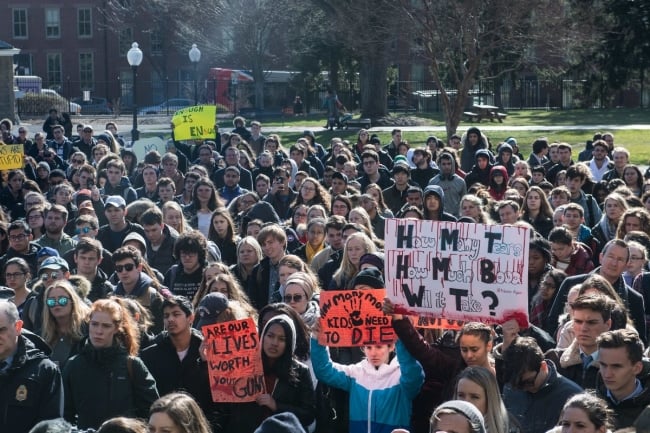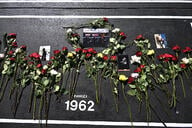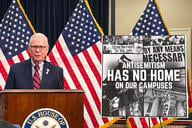You have /5 articles left.
Sign up for a free account or log in.

Georgetown University students protest gun violence after the Marjory Stoneman Douglas High School shooting in 2018.
Nicholas Kamm/Getty Images
Recent mass shootings at an elementary school in Uvalde, Tex., and a supermarket in Buffalo, N.Y., have prompted new calls for higher education institutions to step up efforts to prevent gun violence on campus.
During a webinar Tuesday hosted by United Educators, an insurance company with 1,600 K-12 and higher education members, education leaders received guidance on how to make their institutions safer. Marisa Randazzo, executive director of threat management at Ontic, a protective intelligence software company, said assessing behavioral threats on campus can help thwart mass shootings.
“What we know from the research is that the people who carry out school shootings in K-12, as well as in higher ed, typically follow a detectable progression of behavior, meaning that they first come up with some idea to engage in harm,” Randazzo said.
Behavioral threat assessment teams are the best available tool to identify someone on a “pathway to violence,” from conception to execution of the crime, Randazzo said. In higher education, such teams typically include campus police, administrators and mental health professionals. But there aren’t reliable data on how many K-12 school districts or colleges actually use teams to assess behavioral threats in their midst.
"The most important message I want everyone to take away from this is that it is absolutely possible to prevent acts of violence within our educational institutions,” Randazzo said. “I’m not saying that we will prevent every one of them … this is not necessarily a panacea for all problems that schools and colleges and universities are facing.”
Randazzo said a person planning a mass shooting often tells other people ahead of time about their plans. Would-be perpetrators frequently post messages on social media or even reference their intentions in homework assignments. She noted that many perpetrators make their plans public because they want to be stopped.
Sometimes perpetrators are suicidal, she added, and view mass shootings as their only way out. Professionals equipped to identify threatening behavior can intervene before they get to that point and guide them toward mental health help.
“School shootings are preventable, because the people who engage in them—and they’re often students—follow this detectable pathway to violence,” Randazzo said. “We stand a chance at identifying someone who’s on that pathway before they get to that last step and before they get to doing harm.”
Randazzo also recommended that colleges and universities establish a relationship with the local Federal Bureau of Investigation field office, which can work with campus security or the department of public safety.
“One thing that we’ve actually seen done really well at higher ed, especially, is that there are dedicated liaison officers within the FBI and all the major FBI field offices whose job it is to do outreach to colleges and universities within their jurisdiction,” Randazzo said.
Mass Shootings on Campus
Colleges and universities have seen their fair share of gun violence, in some cases implementing preventive measures in response. In 2007, a gunman killed 32 people and wounded 17 at Virginia Tech. Since then, Virginia Tech and other institutions have installed locks on the inside of classroom doors and replaced the hardware on double doors with handles that cannot be chained together and locked.
The Virginia Tech shooting also led to a change in the 1990 Clery Act, the federal law that requires institutions to collect and report campus crime statistics and mandates that institutions create an emergency warning system to dispatch information as quickly as possible.
Other campuses that have experienced mass shootings include Northern Illinois University, where a former sociology student shot and killed five and wounded 17 in 2008, and Umpqua Community College, where a student shot and killed nine and wounded eight others in 2015.
Pedro Noguera, dean of the University of Southern California’s Rossier School of Education, is part of a coalition of researchers that released an updated eight-point plan after the Uvalde shooting, which urges an evidence-based approach to reducing gun violence in the U.S. Noguera said the eight-point plan can be directly applied to higher education institutions.
Among other things, the plan recommends that schools and higher ed institutions make sure they have enough counselors, psychiatrists, psychologists and social workers for individuals with potential risk factors, such as mental illness. At the same time, it cautions that violence is not necessarily always a product of mental illness.
The plan also recommends creating a national program to train mental health and law enforcement partners to work together on crisis intervention and threat assessment teams. The program should allow people to anonymously report those who might be displaying warning signs but also protect those identified from being unfairly incriminated.
“I think the real emphasis there is on the prevention measures—that is for colleges and universities to kind of really keep track of the warning signals,” Noguera said. “Because what we know is that often when it’s somebody who’s associated with the campus, others knew in advance that there was a problem brewing, either from social media posts or comments they overheard.”
Noguera added that most higher ed institutions need to conduct active shooter drills just in case. Arizona State University, the University of Utah and the University of Nebraska at Omaha already conduct such training.
“Unfortunately, we’re all vulnerable,” Noguera said. “I think any place where there are large numbers of people gathered on a regular basis is vulnerable. We have to take it very seriously. And that’s certainly true for colleges and universities.”
For Noguera, the eight-point plan gives institutions an opportunity to implement change immediately, rather than wait for national legislation.
“Even in the absence of leadership from policy makers, there are actions that people who run large organizations can take to address safety,” Noguera said. “And so let them be the audience. It would be great if we had leadership in Washington and state capitols to reduce access to firearms, but there’s no way that’s gonna happen anytime soon.”
Temple University is taking a community-based approach to prevent gun violence, said Caterina Roman, a criminal justice professor at Temple. After a student was shot and killed near campus in November, Temple created a task force on violence reduction that includes students, faculty and staff, and community members.
The institution this year also created an incentive for landlords—giving them up to $2,500 grants to upgrade security by installing lighting or cameras. And parents of students who live off campus even went as far as hiring private security to patrol neighborhoods adjacent to the campus in March.
“We have a public safety force that’s dedicated and that works closely with the surrounding areas … we were on the cutting edge of what we were doing to support our students to make them feel safe,” Roman said. “I would say that, given this student’s death, Temple has done so much more since then. But we were always doing a very strong set of innovative initiatives and had our police force being collaborative.”
Temple’s newly formed task force is a model of how institutions can work with the community to make both safer at a time when indiscriminate gun violence threatens everyone.
“I do think universities realize they can’t just go business as usual,” Roman said. “We’re doing all these things, but maybe they’re being done piecemeal. How do we collaborate—the right hand knows what the left hand is doing—so we have much more impact, right, that will benefit our students and it’ll benefit the communities?”




